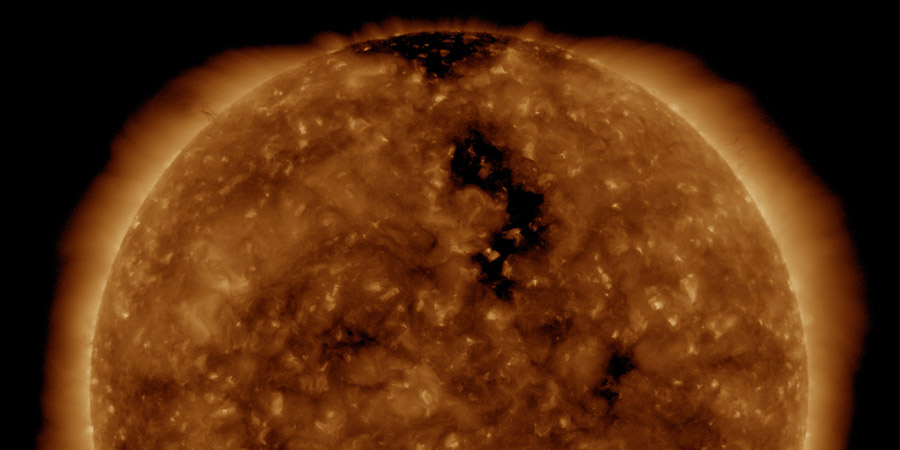Coronal hole, Transit to Solar Cycle 25
Saturday, 8 February 2020 11:36 UTC

A coronal hole is facing our planet today. It is a slim southern extension of the northern hemisphere polar coronal hole. The effects of this coronal hole could reach Earth on Monday (10 February) as a high speed solar wind stream could sweep past our planet and spark some more high latitude aurora displays.
Yes we wrote ''more'' as we are right now seeing the effects of a coronal hole solar wind stream already. The solar wind stream we are currently in comes from an extension of the southern hemisphere polar coronal hole. It was a surprise for us that the effects of that coronal hole were so strong: we even managed to reach active geomagnetic conditions (Kp4) back on Thursday and Friday. So charge those camera batteries, there could be more in store for you this Monday if you are a high latitude sky watcher. But now lets talk about a completely different topic:
Transit to Solar Cycle 25
News flash: we are close to solar minimum! Okay... fair enough... that shouldn't be news to you. Our Sun has been very quiet with little activity and very little sunspots for literally years now. The last significant solar activity with M and X-class solar flares popping of occurred all the way back in 2017. But this is all very normal and to be expected as we transit from Solar Cycle 24 to Solar Cycle 25.
So how long do we have to wait for Solar Cycle 25 to ramp up? The NOAA SWPC has announced back in December that it expects solar minimum to occur (the month with the lowest smoothed sunspot number) in April of 2020 but there is an uncertainty range here of +/- 6 months. We might have already passed solar minimum or we still have to wait until the end of the year! Either way, that means there is light at the end of the tunnel but how do we know which sunspot groups belong to which solar cycle? We are already now occasionally seeing sunspot groups that belong to both solar cycles on the solar disk. This is also very normal behavior by the way. When Solar Cycle 25 ramps up we will still see the odd sunspot region popping up that belongs to Solar Cycle 24.
But to answer the question that many of you have: old Solar Cycle 24 sunspots are now appearing at low latitudes (close to the solar equator) and when you look at magnetogram images from SDO you will see that they have negative polarity sunspots leading when they are in the northern hemisphere and in the southern hemisphere you will see that sunspot regions have positive polarity sunspots leading the way.
Solar Cycle 25 sunspots will appear at a much higher latitude (closer to the solar poles) and have the opposite polarity (positive polarity) leading in northern hemisphere sunspot regions and negative polarity sunspots will be leading the way in the southern hemisphere.
With leading we mean the sunspots on the right side of sunspot groups as viewed from Earth (and SDO's) perspective. As the Sun rotates you will see that these sunspots ''lead'' so to speak and the spots on the left side of sunspot groups will ''follow'' these leading sunspots. The spots that follow (those on the left side of a sunspot group) are what we call the trailing sunspots. When we are analyzing and writing about interesting sunspot regions here on SpaceWeatherLive we often use these terms so it is important to remember this. Sunspots groups can become very complex where it will be hard to talk about leading and trailing sunspots but your average beta sunspots groups will have a clear pattern with leading and trailing sunspots each having their own polarity.
We can take sunspot region 2192 (from Solar Cycle 24) as an example. While this was a massive and complex sunspot region you can still see the leading positive polarity (blue on the magnetogram images from SDO) and the trailing negative (red) polarity sunspots. If sunspot region 2192 would have been a Solar Cycle 25 sunspot group it would have been the other way around.
Hope this was helpful and you learned something new today! With Solar Cycle 25 ahead of us there will be a totally new generation of sky watchers itching to learn more about solar activity. We hope we from SpaceWeatherLive will be your go-to source for everything you want to learn about space weather! If you have any questions do not hesitate to leave a comment or post on our forum!
Thank you for reading this article! Did you have any trouble with the technical terms used in this article? Our help section is the place to be where you can find in-depth articles, a FAQ and a list with common abbreviations. Still puzzled? Just post on our forum where we will help you the best we can!
Latest news
Latest forum messages
Support SpaceWeatherLive.com!
A lot of people come to SpaceWeatherLive to follow the Sun's activity or if there is aurora to be seen, but with more traffic comes higher server costs. Consider a donation if you enjoy SpaceWeatherLive so we can keep the website online!

Space weather facts
| Last X-flare | 2025/03/28 | X1.1 |
| Last M-flare | 2025/04/30 | M1.9 |
| Last geomagnetic storm | 2025/04/21 | Kp5+ (G1) |
| Spotless days | |
|---|---|
| Last spotless day | 2022/06/08 |
| Monthly mean Sunspot Number | |
|---|---|
| March 2025 | 134.2 -20.4 |
| Last 30 days | 123.3 -5.8 |


